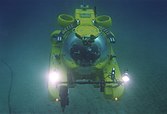
Back Mariene biologie Afrikaans Biolochía marina AN علم الأحياء البحرية Arabic Okean biologiyası Azerbaijani Океан биологияһы Bashkir Біялогія акіяна Byelorussian Морска биология Bulgarian Biologia marina Catalan Hāi-iòng Sĕng-ŭk-hŏk CDO Bioleg forol Welsh
| Part of a series on |
| Biology |
|---|
Marine biology is the scientific study of the biology of marine life, organisms in the sea. Given that in biology many phyla, families and genera have some species that live in the sea and others that live on land, marine biology classifies species based on the environment rather than on taxonomy.
A large proportion of all life on Earth lives in the ocean. The exact size of this large proportion is unknown, since many ocean species are still to be discovered. The ocean is a complex three-dimensional world[1] covering approximately 71% of the Earth's surface. The habitats studied in marine biology include everything from the tiny layers of surface water in which organisms and abiotic items may be trapped in surface tension between the ocean and atmosphere, to the depths of the oceanic trenches, sometimes 10,000 meters or more beneath the surface of the ocean. Specific habitats include estuaries, coral reefs, kelp forests, seagrass meadows, the surrounds of seamounts and thermal vents, tidepools, muddy, sandy and rocky bottoms, and the open ocean (pelagic) zone, where solid objects are rare and the surface of the water is the only visible boundary. The organisms studied range from microscopic phytoplankton and zooplankton to huge cetaceans (whales) 25–32 meters (82–105 feet) in length. Marine ecology is the study of how marine organisms interact with each other and the environment.
Marine life is a vast resource, providing food, medicine, and raw materials, in addition to helping to support recreation and tourism all over the world. At a fundamental level, marine life helps determine the very nature of our planet. Marine organisms contribute significantly to the oxygen cycle, and are involved in the regulation of the Earth's climate.[2] Shorelines are in part shaped and protected by marine life, and some marine organisms even help create new land.[3]
Many species are economically important to humans, including both finfish and shellfish. It is also becoming understood that the well-being of marine organisms and other organisms are linked in fundamental ways. The human body of knowledge regarding the relationship between life in the sea and important cycles is rapidly growing, with new discoveries being made nearly every day. These cycles include those of matter (such as the carbon cycle) and of air (such as Earth's respiration, and movement of energy through ecosystems including the ocean). Large areas beneath the ocean surface still remain effectively unexplored.
- ^ Oceanographic and Bathymetric Features Marine Conservation Institute. Uploaded 18 September 2013.
- ^ Foley, Jonathan A.; Taylor, Karl E.; Ghan, Steven J. (1991). "Planktonic dimethylsulfide and cloud albedo: An estimate of the feedback response". Climatic Change. 18 (1): 1. Bibcode:1991ClCh...18....1F. doi:10.1007/BF00142502. S2CID 154990993.
- ^ Sousa, Wayne P. (1986) [1985]. "7, Disturbance and Patch Dynamics on Rocky Intertidal Shores". In Pickett, Steward T. A.; White, P. S. (eds.). The Ecology of Natural Disturbance and Patch Dynamics. Academic Press. ISBN 978-0-12-554521-1.



